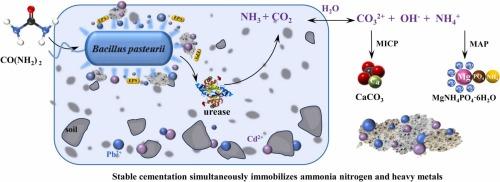Synchronous removal of heavy metals and ammonia-nitrogen by magnesium ammonium phosphate (MAP)-enhanced microbial induced calcite precipitation (MICP)
IF 11.3
1区 环境科学与生态学
Q1 ENGINEERING, ENVIRONMENTAL
引用次数: 0
Abstract
Microbially induced calcium carbonate precipitation (MICP) can be used to remediate heavy metal-contaminated soils. However, its remediation efficiency requires improvement, and the generation of ammonia nitrogen limits its practical application. We employed the magnesium ammonium phosphate precipitation method (MAP) to generate bio-struvite, which effectively immobilized ammonia, reduced the leaching toxicity of heavy metals, and promoted the transformation of Pb and Cd into more stable forms, thereby reducing their toxicity and bioavailability. Adsorption simulations have also demonstrated that bio-struvite has a stronger adsorption capacity for heavy metals and forms tighter adsorption bonds. Confocal Laser Scanning Microscope (CLSM) captured the formation process of bio-struvite, which together with the X-ray diffraction (XRD) pattern, corroborated the presence of bio-struvite. The formation of bio-struvite also effectively filled the soil pores. As an environmentally friendly and high-quality slow-release fertilizer, bio-struvite was tested for its N/P slow-release effect through soil column leaching experiments, which confirmed its ability to enhance soil fertility. Therefore, this approach not only provides a perspective for addressing the issue of ammonium nitrogen, but also explores the application of biomineralization in the field of heavy metal pollution. The research outcomes hold promise for future practical engineering applications.

磷酸铵镁(MAP)强化微生物诱导方解石沉淀(MICP)同步去除重金属和氨氮
微生物诱导碳酸钙沉淀(MICP)可用于重金属污染土壤的修复。但其修复效率有待提高,且氨氮的生成限制了其实际应用。我们采用磷酸铵镁沉淀法(MAP)制备生物鸟粪石,有效地固定氨,降低重金属的浸出毒性,促进Pb和Cd转化为更稳定的形态,从而降低其毒性和生物利用度。吸附模拟也表明生物鸟粪石对重金属的吸附能力更强,形成更紧密的吸附键。共聚焦激光扫描显微镜(CLSM)捕捉到了生物鸟粪石的形成过程,并结合x射线衍射(XRD)图证实了生物鸟粪石的存在。生物鸟粪石的形成也有效地填充了土壤孔隙。生物鸟粪石作为一种环保型优质缓释肥料,通过土壤柱淋试验测试了其氮磷缓释效果,证实了其提高土壤肥力的能力。因此,该方法不仅为解决铵态氮问题提供了一个视角,也探索了生物矿化在重金属污染领域的应用。研究成果对未来的实际工程应用具有重要意义。
本文章由计算机程序翻译,如有差异,请以英文原文为准。
求助全文
约1分钟内获得全文
求助全文
来源期刊

Journal of Hazardous Materials
工程技术-工程:环境
CiteScore
25.40
自引率
5.90%
发文量
3059
审稿时长
58 days
期刊介绍:
The Journal of Hazardous Materials serves as a global platform for promoting cutting-edge research in the field of Environmental Science and Engineering. Our publication features a wide range of articles, including full-length research papers, review articles, and perspectives, with the aim of enhancing our understanding of the dangers and risks associated with various materials concerning public health and the environment. It is important to note that the term "environmental contaminants" refers specifically to substances that pose hazardous effects through contamination, while excluding those that do not have such impacts on the environment or human health. Moreover, we emphasize the distinction between wastes and hazardous materials in order to provide further clarity on the scope of the journal. We have a keen interest in exploring specific compounds and microbial agents that have adverse effects on the environment.
 求助内容:
求助内容: 应助结果提醒方式:
应助结果提醒方式:


